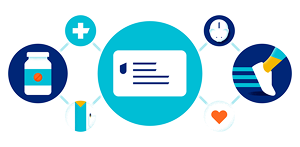When you’re sick, the last thing you want to do is get out of bed, get dressed and drive to the doctor’s office. For one, you’ll probably have to sit in a waiting room full of people and their germs. And as the name of the room implies, you’ll have to wait.
But a great alternative has made things a lot easier in recent years. Telehealth, which you might also see called telemedicine or virtual care, allows people to book an appointment with a provider, virtually. You’ll meet with them over a secure web portal or video chat via your smartphone (data rates may apply), laptop or tablet, in the comfort of your own home.
Telehealth is best for nonemergency medical conditions — things like colds, mental health conditions and skin issues. And because the providers may be available outside of normal office hours, you might be able to avoid long wait times or even an after-hours trip to an urgent care or the emergency room.
Simply put, telehealth is big on convenience. Here are 9 ways to prepare for your next telehealth appointment — plus, some pro tips on how to maximize your experience.
Want to skip the waiting room? A telehealth membership provides care for general medicine, behavioral health and dermatology. Explore it today.
1. Fill out any paperwork
Ask if your provider has any forms or paperwork that you’ll need to fill out in advance of your telehealth appointment. For example, you may need to verify any prescription drugs that you’re currently taking in the app or on the web portal, or your provider may have an online symptom checklist.
Pro telehealth tip: When you make the telehealth appointment, ask if you need to be available before the appointment and for how long. Some providers will have a nurse or medical assistant call to update your records before the actual appointment.
2. Update your medication list
Besides noting the medications you’re currently taking in their records, the provider might ask the same question during the telehealth visit. You’ll want to make a list of your current medications and be ready to report the details, such as frequency and dosage. For example, if you’re talking to a mental health provider, they’ll want to know if you’re taking an antidepressant or antianxiety medication.
Also, you’ll want to tell the provider what you’ve taken recently, including any over-the-counter medications or supplements. For example, if you have a fever, the provider may ask if you’ve taken any medications, such as ibuprofen or acetaminophen, to bring the fever down.
Pro telehealth tip: Have any medication bottles within arm’s reach, so you can look at them if you need more details. Or you can just snap a photo of them and send them to the provider during the telehealth visit.
3. Be prepared to summarize your symptoms
Just like an in-person visit, you’ll want to be able to summarize your symptoms, including their frequency, severity and duration. For example, a mental health professional will want to know how long you’ve been feeling depressed or anxious. And if you’re seeing a doctor, you’ll need to describe your symptoms in the best way. Is your pain dull or sharp? Is it constant, or does it come and go? What makes it better or worse?
Pro telehealth tip: Take your temperature and weigh yourself beforehand, so you have those numbers ready.
4. Have your questions ready
You may have questions you want to ask a provider. Jot them down on a piece of paper or in a note-taking app, so that you have them handy for your telehealth visit. If you anticipate getting a prescription, for instance, you’ll want to ask about side effects, how long it will take to do its job, and whether you’ll want to take it on an empty (or full) stomach.
Pro telehealth tip: Repeat back the doctor’s answers to your questions to double-check that you understand them. You can also write out the answers on a notepad or the app you used.
Enter your ZIP code to find the virtual care options available in your area.
5. Install any software you might need
Some health care providers use a telehealth app for virtual visits, which you’ll need to download and install on your smartphone, tablet or computer. Others may have you access a secure web portal via an internet browser. Find out what’s required from your provider beforehand and install any software in advance.
Pro telehealth tip: Install the software on multiple devices, so you have backup device if one of them isn’t working properly.
6. Make sure your tech is working
As part of your virtual doctor visit preparation, make sure whatever hardware you need is up and running. Also, you’ll want to:
- Check that your internet connection or wireless signal is working.
- Test your audio and video, to ensure that you can have a 2-way conversation.
- Be sure the devices you’re using are fully charged or plugged in.
Pro telehealth tip: If you’re using a mobile device, such as a phone or tablet, use a holder or prop it up securely in a position that shows your face, so you don’t have to hold it during the visit.
7. Choose a private, well-lit space to talk
Since you’re going to be talking about personal health or mental health issues, you’ll want to find a quiet, private area in your house for the visit. You’ll want it to be comfortable and well lit, so you’re at ease and your provider can see you during the telehealth visit.
Pro telehealth tip: If your telehealth appointment is for a sick child, you’ll both need to be on the call, so get yourselves situated in such a way that you can both be seen and heard on the screen. If you have a child and the appointment is for your own mental health therapy, on the other hand, try seeing if a friend or family member can watch your child while you’re having the appointment.
8. Ask about next steps
Whether you’re talking to a therapist or a doctor, you’ll want to confirm any follow-up steps with them. That could be when your next therapy session will happen. Or if it’s with a doctor and they order lab work, find out when you’ll get the results and how you’ll hear about them. (Obviously, you’ll need to do an in-person visit to get lab work done.)
Pro telehealth tip: See if your doctor provides an online after-visit summary that lists the next steps you should take.
9. Book your telehealth visit
Depending on your health insurance plan, you may already have access to telehealth benefits. You’ll want to confirm with your insurer — or your company’s human resources department — whether that is the case. If you don’t, there are still ways you can get telehealth. For example, a telehealth membership provides general medicine, behavioral health and dermatology for $20 a month. You can call a licensed insurance agent at 1-844-211-7730 for more information.
For informational purposes only. This information is compiled by UnitedHealthcare, and/or one of its affiliates, and does not diagnose problems or recommend specific treatment. Services and medical technologies referenced herein may not be covered under your plan. Please consult directly with your primary care physician if you need medical advice.
Compliance code:
51831-X-1224










